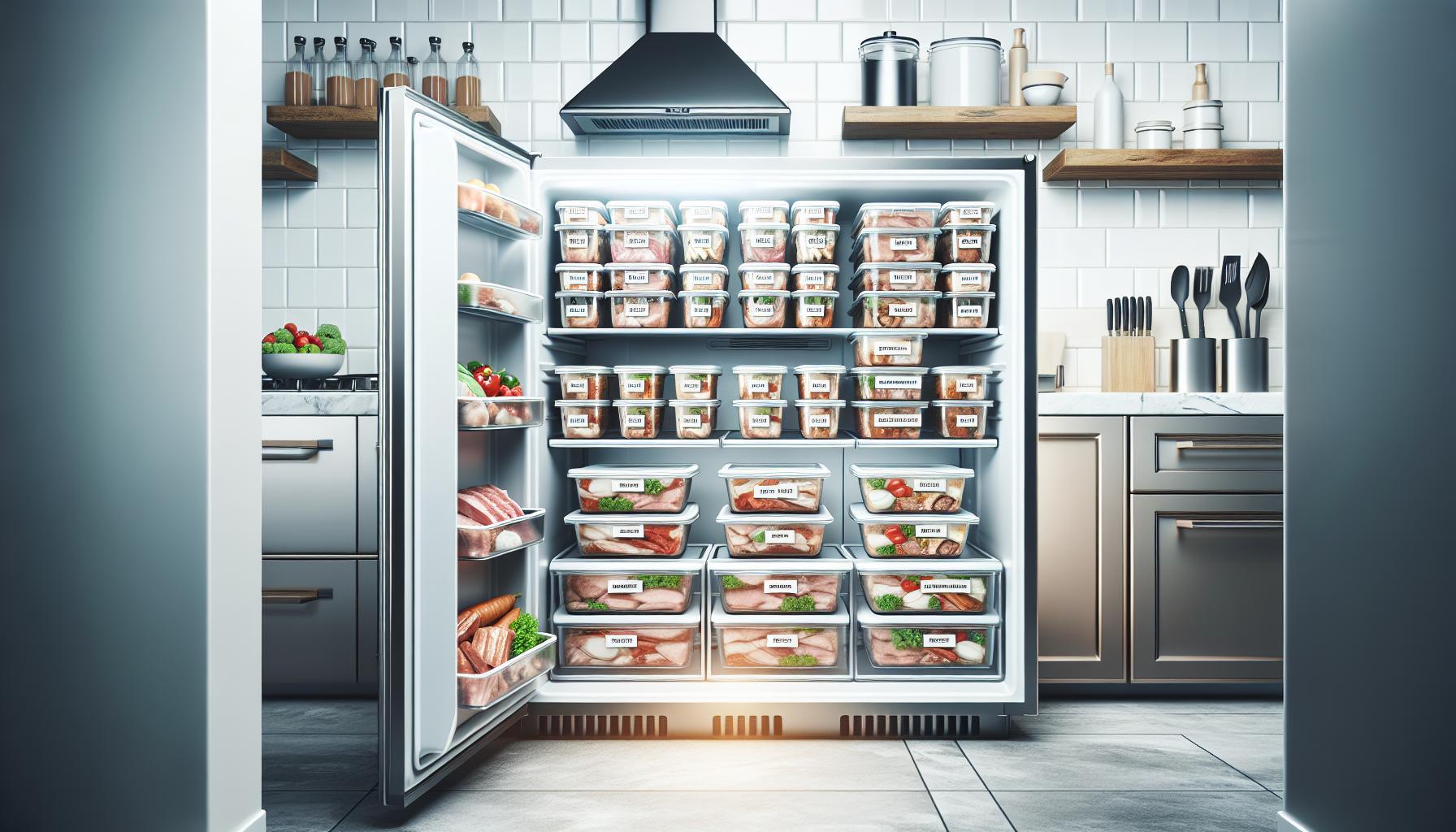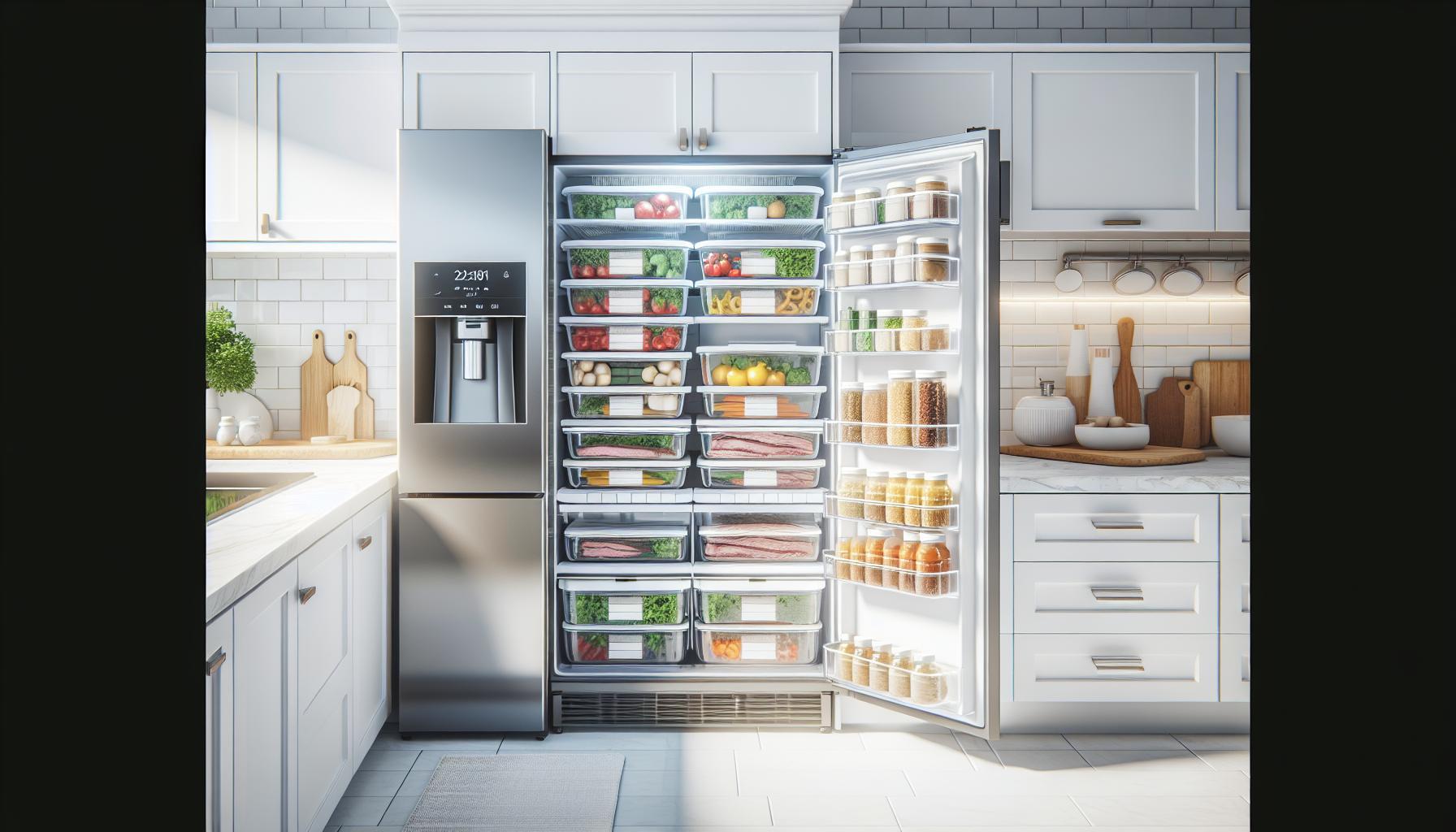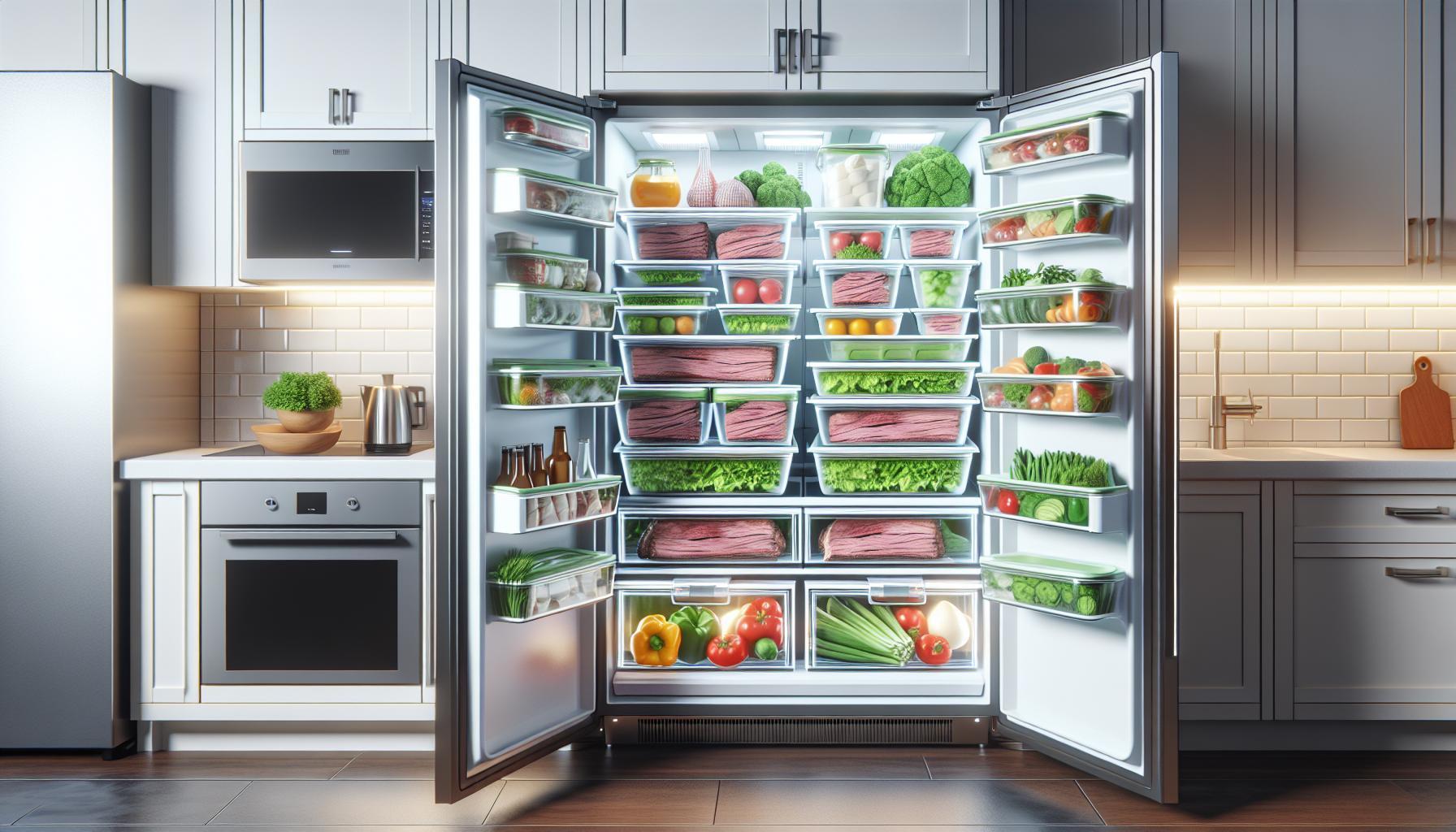Summer sausage is a beloved staple for picnics, charcuterie boards, and quick snacks, but knowing how long it lasts in the fridge is crucial for food safety. With its robust flavors and convenient storage, it’s easy to overlook the potential for spoilage. Understanding the shelf life and proper storage practices for summer sausage can ensure you enjoy its taste without risking your health.
Many people are concerned about food safety, especially when it comes to cured meats. Whether you’ve just opened a package or have some leftovers from a gathering, knowing how to store your summer sausage effectively can help prevent waste and unexpected spoilage. In this guide, we’ll explore the recommended time frames for refrigeration, best practices for storage, and tips on recognizing when your summer sausage is no longer safe to eat. Read on to empower yourself with the knowledge needed to enjoy this delicious treat safely and confidently.
How Long Can Summer Sausage Be Stored in the Fridge?
Proper storage is crucial for maintaining the quality and safety of summer sausage. In general, when summer sausage is stored in the fridge, it can remain in good condition for up to three months. However, for optimal freshness and flavor, it is best consumed within two to three weeks once opened. The unique preservation methods used during processing allow summer sausage to have a longer shelf life compared to fresh meat, but it is still important to adhere to recommended time frames to avoid spoilage.
When you purchase summer sausage, the packaging often provides a “best by” or “use by” date; this serves as a guideline for quality rather than safety. If unopened and stored properly in your refrigerator, the sausage can last up to six months past this date. For opened summer sausage, wrapping it tightly in plastic wrap or aluminum foil helps to prevent exposure to air and moisture, which can reduce its lifespan significantly. Always keep it in the coldest part of the fridge, away from the door where temperatures may fluctuate.
It’s essential to monitor the sausage for any changes in color, texture, or smell, as these can indicate spoilage. If you’re unsure about the sausage’s safety, it’s always best to err on the side of caution and discard it. By following proper storage and handling practices, you can enjoy summer sausage safely and deliciously!
Factors Affecting the Shelf Life of Summer Sausage
Summer sausage’s longevity in your refrigerator hinges on various factors that can significantly influence its shelf life. Understanding these can empower you to best preserve this beloved snack while enjoying its flavors at their peak.
One of the primary is the initial packaging. Store-bought summer sausage typically comes vacuum-sealed, which greatly enhances its ability to stay fresh longer. If this packaging remains intact and the sausage is stored properly, it can last for up to six months past its “best by” date. Once opened, however, the clock starts ticking more swiftly. To maximize its lifespan post-opening, ensure it’s tightly wrapped in plastic wrap or aluminum foil to minimize exposure to air and moisture, which can catalyze spoilage.
Temperature plays a vital role as well; summer sausage should be kept at temperatures below 40°F (4°C) for optimal preservation. Ideal locations in the refrigerator include the back of the bottom shelf, as these areas tend to maintain a more consistent temperature compared to the door compartments. If you live in a particularly humid climate, the moisture in the air can also affect the sausage’s quality, so be diligent about proper sealing.
Other factors involve the level of processing and ingredients used. Artisan or homemade summer sausages might have different shelf lives compared to commercially made varieties due to variations in ingredients and preparation methods. Additionally, the presence of preservatives can extend freshness significantly. Always check the specific details on the label and be aware of the type of summer sausage you are storing. By paying attention to these factors, you can ensure that your summer sausage remains delicious and safe to consume well beyond its average shelf life.
Signs of Spoilage in Summer Sausage
The key to enjoying summer sausage lies in knowing how to identify spoilage early. Recognizing the signs can save you from consuming potentially harmful products that could lead to food poisoning. Spoilage may not always be overt, so being vigilant is crucial.
One of the first indicators of spoilage is a change in smell. Fresh summer sausage typically has a savory, slightly tangy aroma. If you detect a strong, sour, or rancid odor, it’s best to discard it. Additionally, look for changes in texture; the sausage should remain firm to the touch. If it becomes slimy or excessively sticky, this is a clear sign that bacteria may have developed.
Appearance is another critical factor. Check for any discoloration or unusual spots, as these can signal mold growth, particularly if you notice white or green patches. While some types of mold can be harmless, it’s better to err on the side of caution. Always inspect the packaging as well; if you notice any holes or tears, the sausage inside may have been compromised.
Lastly, trust your instincts-if something seems off and you have doubts about the sausage’s freshness, it’s safer to dispose of it. Keeping your summer sausage in optimal storage conditions certainly helps extend its shelf life, but awareness of spoilage signs ensures you enjoy this delicacy safely and deliciously.
Proper Storage Techniques for Summer Sausage
To maintain the quality and safety of summer sausage, proper storage techniques are essential. Ideally, summer sausage should be stored in the refrigerator at or below 40°F (4°C) to prolong its shelf life. When properly stored, unopened summer sausage can last several months, while once opened, it is best consumed within three weeks for optimal taste and safety.
To maximize freshness, store summer sausage in its original packaging until ready to use. If the packaging has been opened, wrap the sausage tightly in plastic wrap or aluminum foil to minimize exposure to air, which can lead to drying and spoilage. Placing it in an airtight container can provide an additional layer of protection against moisture and odors from other foods. Avoid storing summer sausage in high-humidity environments or near strong-smelling foods, as this can affect its flavor profile.
For extended storage, consider freezing summer sausage. When freezing, wrap it tightly in freezer-grade plastic wrap or aluminum foil, then place it in a resealable freezer bag to prevent freezer burn. Properly frozen summer sausage can last up to six months. Remember to label the packaging with the date of freezing, as this will help you keep track of its shelf life.
When you’re ready to use frozen summer sausage, thaw it safely in the refrigerator for several hours or overnight. Avoid thawing at room temperature, as this can encourage bacteria growth. Once thawed, consume the sausage within a week for the best quality. Following these straightforward storage techniques ensures that your summer sausage remains delicious, safe, and ready to enjoy whenever you need it.
How to Freeze Summer Sausage for Longer Preservation
To ensure your summer sausage remains delicious and safe for an extended period, freezing is one of the most effective preservation methods you can utilize. When done properly, freezing can keep summer sausage at peak quality for up to six months. This is a great option if you find yourself with excess sausage or if you’re looking to purchase in bulk. The goal is to prevent any quality loss or spoilage that can occur over time when stored in the refrigerator alone.
Begin by preparing the summer sausage for freezing. If it’s still in its original packaging and unopened, you can simply place it in the freezer. However, for optimal results, particularly if the packaging is open or you’re dealing with a homemade variety, take the following steps:
- Wrap tightly: Use freezer-grade plastic wrap or aluminum foil to wrap the sausage tightly. This helps to eliminate air exposure, which can cause freezer burn.
- Use airtight containers: For an added layer of protection, place the wrapped sausage in a resealable freezer bag or an airtight container. This limits the sausage’s exposure to moisture. If using a bag, try to remove as much air as possible before sealing.
- Label and date: Don’t forget to label the packaging with the date of freezing. This will help you keep track of how long it has been stored and ensure you use it within the best-quality timeframe.
Once packed correctly for freezing, place the sausage in the coldest part of your freezer. When you’re ready to use it, thaw it safely in the refrigerator to maintain its quality. Avoid thawing at room temperature, as this can promote bacterial growth. After thawing, it’s best to consume the sausage within one week.
By following these simple yet effective methods, you can extend the shelf life of your summer sausage and enjoy it whenever you desire while ensuring safety and taste.
Recognizing Different Types of Summer Sausage and Their Lifespan
Summer sausage is a beloved staple among cured meats, with several varieties that come with different lifespans and storage requirements. Understanding these differences not only helps you enjoy this tasty treat at its best but also ensures you stay within the safety parameters for consumption.
The most common types of summer sausage include beef, pork, venison, and turkey varieties. Each type generally adheres to the same shelf life principles but may have slight variations. Pre-packaged summer sausages often last longer than homemade versions due to preservatives and vacuum-sealed packaging. Typically, commercially packaged summer sausage can last in the fridge for three to six months once opened, while vacuum-sealed and unopened sausage can retain quality for several months, sometimes up to a year. In contrast, homemade summer sausage, made without preservatives, should be consumed within three weeks when refrigerated.
When it comes to recognizing these types, look for labels. A fruity or spicy flavor may indicate a traditional beef summer sausage seasoned with various spices, whereas a venison or turkey version might have a more gamey taste profile. Each type’s fat content can also impact its longevity; for example, higher-fat sausages may spoil faster than leaner ones. Regardless of the variety, always check for signs of spoilage, such as a sour smell or discoloration, before consumption.
To maximize freshness and safety, store summer sausage in its original packaging until ready to use. If you anticipate keeping it for longer, consider freezing, which can extend its lifespan even further, particularly for homemade varieties. This way, you’ll not only enjoy the delicious flavor of summer sausage for many meals but also do so with confidence in its quality and safety.
The Importance of Vacuum Sealing for Storage
Vacuum sealing is an essential technique when it comes to maximizing the shelf life of summer sausage, ensuring that you get the most out of your purchase while maintaining safety and flavor. By removing air from the packaging, vacuum sealing significantly reduces the growth of bacteria and mold, which thrive in oxygen-rich environments. This method not only helps to keep summer sausage fresh for a longer time, but it also preserves its texture and taste, making every bite enjoyable.
When stored properly in vacuum-sealed packaging, unopened summer sausage can last anywhere from six months to a year in the refrigerator, depending on the variety and fat content. For opened sausages, vacuum sealing can extend their life for an additional three to four months compared to traditional storage methods. To vacuum seal your summer sausage, consider investing in a home vacuum sealing machine or utilizing vacuum seal bags that can be manually sealed, ensuring that removing all air effectively.
Moreover, vacuum sealing allows you to store sliced sausage with ease. For instance, you can portion out servings for quick meals or snacks, which also minimizes the risk of spoilage. Just remember to label each package with the date it was sealed, as this practice will help you track freshness and minimize waste in your pantry. Understanding the significance of vacuum sealing can transform how avid culinary explorers enjoy their summer sausage, preserving its quality and ensuring food safety in every meal.
Best Practices for Thawing and Using Frozen Summer Sausage
Thawing frozen summer sausage properly is crucial to maintaining its flavor and safety. When you’re ready to enjoy your stored sausage, consider planning ahead to allow adequate time for safe thawing. The preferred method is to transfer the sausage from the freezer to the refrigerator, allowing it to thaw gradually over 24 hours. This ensures that the sausage stays at a safe temperature, minimizing the risk of bacterial growth.
If you need the sausage thawed more quickly, you can opt for the cold water method. Place the sealed sausage in a bowl of cold water, changing the water every 30 minutes to maintain a consistent cold temperature. This method can cut thawing time down significantly, making it a practical choice if you’re short on time. Avoid using warm water or microwaving the sausage to thaw, as these methods can lead to uneven thawing and potentially spoil the meat.
Once thawed, summer sausage can be kept in the refrigerator for an additional three to five days before use. While it’s safe to refreeze partially thawed sausage, doing so can affect its texture and flavor, so it’s best to only thaw what you plan to use. Whether you’re slicing it for a charcuterie board or incorporating it into a savory dish, handling thawed summer sausage with care will ensure a delicious final product. Be sure to consume any leftovers promptly, and if you’re unsure about freshness, always prioritize safety-when in doubt, throw it out!
Tips for Extending the Freshness of Summer Sausage
To maintain the flavor and safety of summer sausage, employing a few effective strategies can significantly extend its freshness. One of the simplest and most effective methods is proper storage. Always keep summer sausage in its original packaging when possible. If you’ve opened the package, wrap the sausage tightly in plastic wrap or aluminum foil to minimize exposure to air, which can lead to spoilage. Storing the sausage in an airtight container or resealable plastic bag can provide additional protection against moisture and odors from other foods.
Another highly recommended practice is to label the packaging with the date of purchase or opening. This will help you keep track of its age and ensure that you use it within a safe timeframe. Generally, summer sausage can last unopened in the fridge for up to six months, and once opened, it should be consumed within three weeks for optimal quality. To further enhance freshness, consider placing the wrapped summer sausage in the coldest part of the refrigerator, typically near the back.
Utilizing vacuum sealing is also a robust option for extending the life of summer sausage. This method removes air from the packaging, thus reducing oxidation and bacterial growth. Vacuum-sealed summer sausage can last for several months in the fridge, and even longer if frozen. When ready to consume, remember to thaw frozen sausage in the refrigerator for best results, as this practice maintains both flavor and texture.
Lastly, incorporating some common food preservation wisdom can help. Avoid leaving summer sausage out at room temperature for extended periods, as doing so can accelerate spoilage. When serving, slice only what you need and store any leftovers promptly to maintain freshness. By following these straightforward tips, you can enjoy your summer sausage at its best for longer, ensuring that each bite is flavorful and safe.
Common Myths About Summer Sausage Storage
The storage of summer sausage is often surrounded by misconceptions that can lead to food safety issues or a subpar eating experience. Many people believe that summer sausage can simply be left out at room temperature for extended periods without any consequence. In reality, while this type of sausage is known for its longer shelf life compared to other meats due to its curing process, it should not be taken for granted. Leaving it unrefrigerated can accelerate spoilage, especially in warmer environments. It’s best to keep summer sausage in the fridge and consume it while it’s fresh.
Another common myth is that vacuum-sealed packaging can indefinitely preserve summer sausage. Although vacuum sealing significantly extends its shelf life, it does not make the sausage impervious to spoilage. For best results, consume vacuum-sealed summer sausage within a few months and always check for signs of spoilage before consuming. Remember, even vacuum-sealed products have a limited lifespan, typically lasting about 3 to 6 months in the refrigerator.
Many believe that the appearance or smell of summer sausage is the sole indicator of its safety. While these factors can help identify potential spoilage, they are not foolproof. For example, some harmful bacteria can grow without producing noticeable changes in texture or odor. This emphasizes the importance of adhering strictly to date labels and recommended storage times to ensure safety.
Finally, the thought that freezing summer sausage will compromise its quality is a misconception. In fact, freezing is an effective preservation method that can maintain both flavor and texture when done correctly. To avoid freezer burn, it’s essential to wrap it tightly in plastic wrap or aluminum foil and place it in an airtight container before freezing. This way, you can enjoy summer sausage at its best for a longer duration. By debunking these myths, you can make informed decisions that ensure both the safety and enjoyment of your summer sausage.
How to Safely Reheat Summer Sausage After Storage
Reheating summer sausage can be a delightful way to enhance your meals, whether you’re adding it to a savory breakfast, a hearty sandwich, or a pizza topping. However, it’s essential to approach reheating with an understanding of food safety and quality to ensure that you enjoy the best flavors without risking spoilage.
To start, make sure to properly thaw the summer sausage if it has been frozen. The safest method is to transfer it from the freezer to the refrigerator and allow it to thaw overnight. If you’re in a hurry, you can use the microwave on its defrost setting, but be cautious to avoid partially cooking it in the process.
Once thawed, you can reheat summer sausage in several ways while preserving its taste and texture. Here are some recommended methods:
Oven Method
1. Preheat your oven to 350°F (175°C).
2. Place the summer sausage in a baking dish or wrap it in aluminum foil to prevent it from drying out.
3. Heat for about 10-15 minutes, or until it reaches an internal temperature of 165°F (74°C), ensuring that it’s heated evenly.
Microwave Method
1. Slice the summer sausage into even pieces or keep it whole, depending on your preference.
2. Place it on a microwave-safe plate and cover it with a damp paper towel to retain moisture.
3. Heat in 30-second intervals, checking the temperature. The goal is to reach an internal temperature of 165°F (74°C).
Skillet Method
1. Heat a non-stick skillet over medium heat.
2. Add sliced summer sausage and allow it to cook for about 3-5 minutes, flipping to heat both sides. Make sure it reaches the safe internal temperature.
Regardless of the method you choose, always check the internal temperature using a food thermometer. This step is critical to ensure food safety and prevent any risk of foodborne illnesses.
Finally, remember that reheated summer sausage should be consumed immediately and should not be reheated more than once. This practice not only maintains flavor and texture but also minimizes food safety risks associated with repeated heating and cooling. Enjoy your culinary creations confidently, knowing that you’ve prioritized both flavor and safety!
FAQ
Q: How can I tell if summer sausage has gone bad?
A: Signs that summer sausage has spoiled include an off or sour smell, slimy texture, discoloration, or mold growth. If you notice any of these symptoms, it’s best to discard the sausage to ensure food safety.
Q: Can you eat summer sausage past the expiration date?
A: While summer sausage can often be safe to eat after the expiration date if stored properly, its quality may degrade. Always check for signs of spoilage before consumption and when in doubt, throw it out.
Q: How long can I keep summer sausage once opened?
A: Once opened, summer sausage can be stored in the fridge for about 3 weeks. For optimal freshness, wrap it tightly and keep it in an airtight container or vacuum-sealed.
Q: What’s the best way to store summer sausage?
A: The best way to store summer sausage is to keep it in its original packaging or wrap it tightly in plastic wrap or aluminum foil. If possible, vacuum sealing is ideal for extending its shelf life.
Q: Is it safe to freeze summer sausage?
A: Yes, summer sausage can be safely frozen to prolong its shelf life. Wrap it securely using freezer wrap or a vacuum seal bag to prevent freezer burn, and it will last for up to 6 months in the freezer.
Q: Should summer sausage be kept in the fridge or freezer?
A: Summer sausage should be kept in the fridge if you plan to consume it within a few weeks. For longer storage, freezing is recommended, as it preserves the quality and safety of the sausage.
Q: What types of summer sausage last the longest?
A: Hard and dry types of summer sausage, like pepperoni and fully cured varieties, typically last longer than softer options. Always consider the specific type and follow proper storage guidelines for maximum longevity.
Q: Can summer sausage be reheated safely?
A: Yes, summer sausage can be reheated safely. Ensure it reaches an internal temperature of 165°F (74°C) before consuming. Slicing it before heating can help ensure even reheating.
Wrapping Up
In summary, understanding how long summer sausage lasts in the fridge is key to ensuring both flavor and safety. Remember to store it properly-unopened summer sausage can last up to a few months beyond its expiration date, while opened portions should ideally be consumed within 3 weeks. To keep your charcuterie experience hassle-free, consider bookmarking our guide on safe food storage practices and exploring our delicious recipes for using summer sausage.
Don’t wait until it’s too late! Dive into our detailed articles on meat storage best practices and how to tell if your sausage has gone bad. If you found this guide helpful, sign up for our newsletter for more expert tips and delicious recipes delivered straight to your inbox. Your feedback matters to us, so feel free to share your thoughts or experiences in the comments below! Let’s keep the conversation going and ensure your culinary adventures are always a success.





